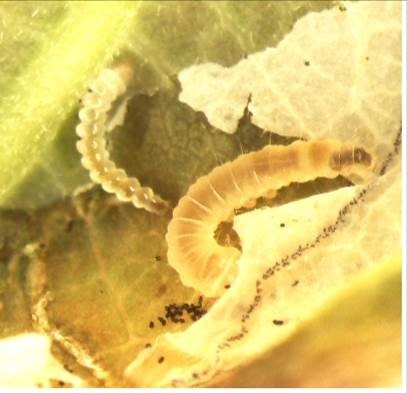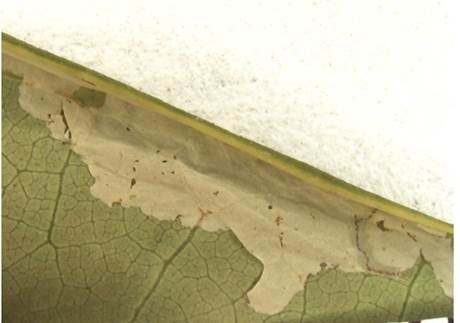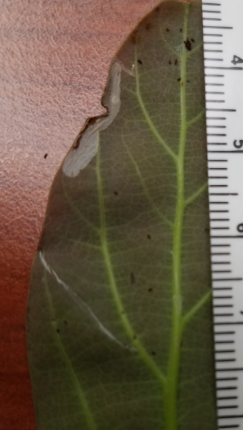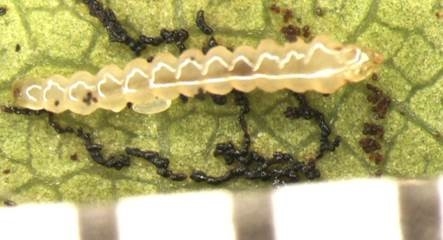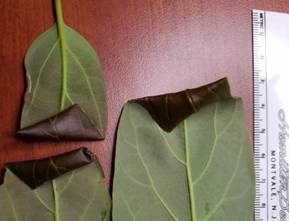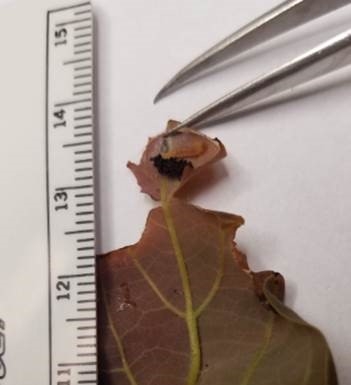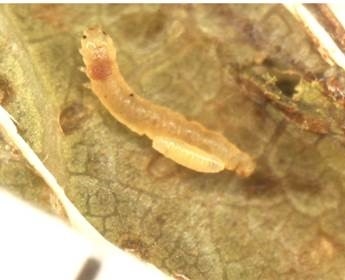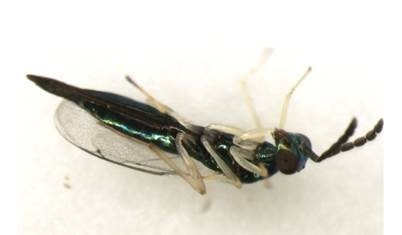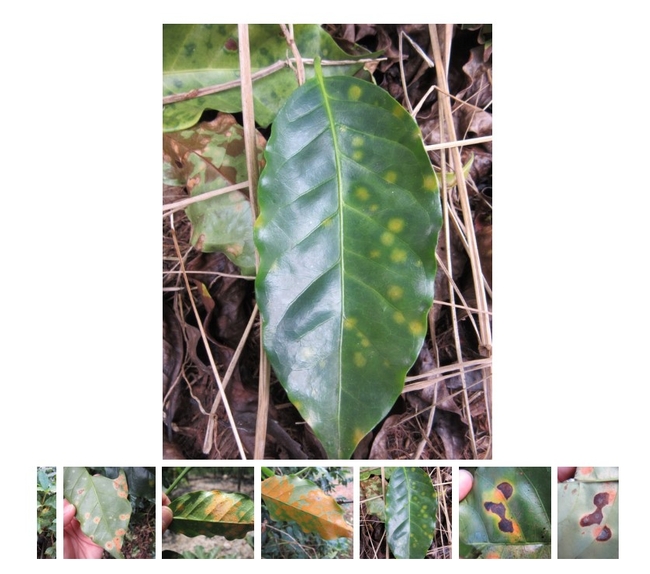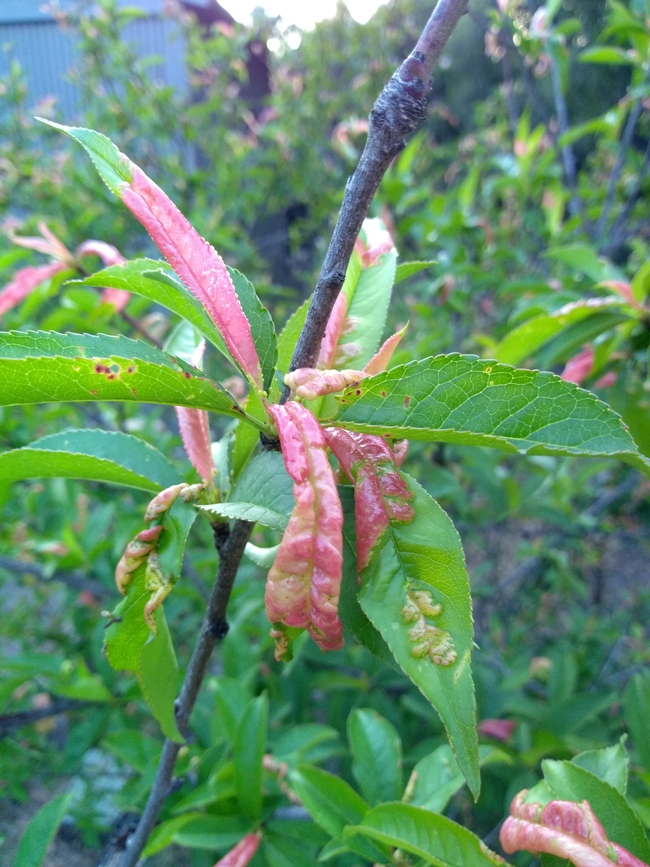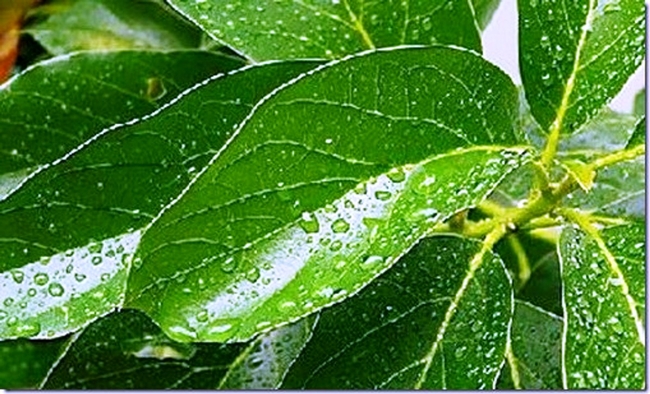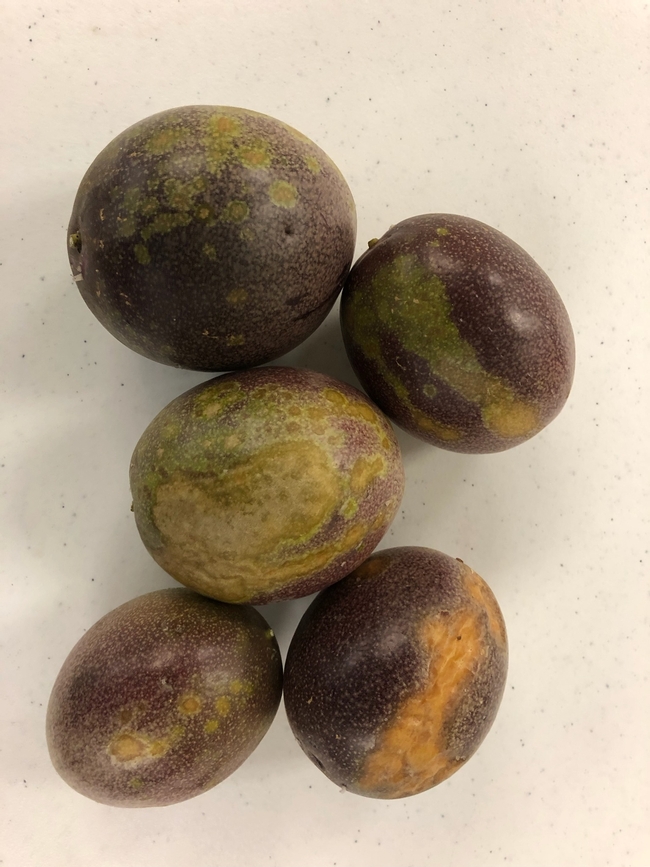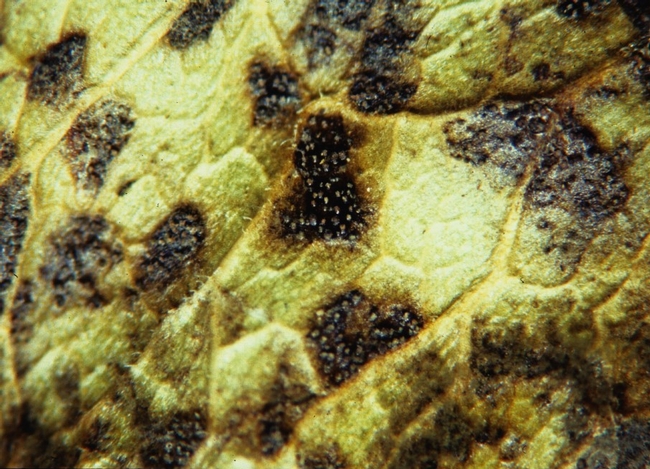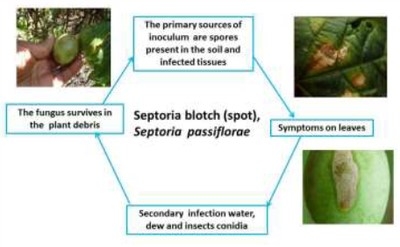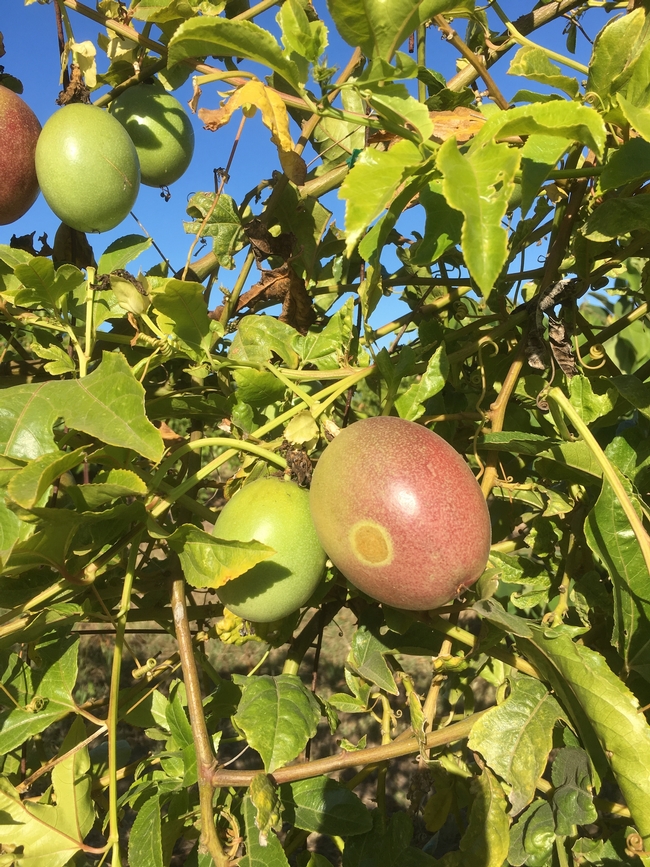
Posts Tagged: c Leaf
No Longer a New Pest
This article was first posted in July of 2020 when it wasn't clear what this leaf roller/leaf miner was going to do. In the last couple of weeks I have heard from two PCAs from Ventura saying that they are having to spray for it. So, it is back and it is probabl6y going to hang around for a while. It does not seem to feed on fruit. It causes damage to leaves but it doesn't seem to be significant on mature trees. On a newly planted tree, it can defoliate it, so it should not be neglected. Read the history below.
A new pest for avocado? Old pest? How much damage will it do? Don't know yet.
Tracy Ellis, the San Diego County Ag Commissioner Entomologist has partially identified what appeared to be two pest and a parasitoid, as only one pest and a beneficial that is doing it's duty going after the pest.
The insect determination has come back for both larvae (one a leaf miner and one a leaf roller) as the same insect! It has been determined to be C-rated gracillariid miner Caloptilia sp. (Lepidoptera: Gracillariidae) at this time. An image of the adult moth is not yet available.
Apparently, the larval stage transitions from a miner to a roller, in what's called hyper-metamorphosis. Starting as a miner and abandoning the mine to roll the leaf. CDFA scientist Marc Epstein is taking a closer look at this insect . Marc does not know if it is a local insect that adapted to avocados or is an import, as many in this family have not been studied or sequenced.
The leaf roller/folder has appeared down in San Diego and Santa Barbara. It's not clear whether it will be a pest of the fruit at this time.
The results for the parasite came back as Hymenoptera. That too needs greater study.
Above is a photo of both insect stages. They can be found together in the same habitat.
The damage from the leaf miner generally looks like this
And miner looks like this
The damage from the leafroller looks like this:
Larval leafroller with the parasite on it.
And the parasite , once it grows up from being a maggot, looks like this
It's still not clear what damage this might do. Maybe nothing significant. Maybe this is an aberration only for this year. Stay tuned.

leaf roller avocado
Coffee Rust in Hawaii!!!!
Coffee Leaf Rust (Hemileia vastatrix) has recently been found in Hawaii.
This is a devastating fungal disease that has been found in most coffee growing areas of the world. It arose in Africa and moved to the Americas, now it is completing the circle, showing up in Hawaii. Coffee is the obligate host of this disease, meaning it only can reproduce on coffee. It needs coffee to survive and it needs to come into contact with another coffee plant for it to spread. It's most likely spread by humans moving infected coffee plant parts around – infected seed or the actual plants. It has caused turmoil in those countries where it has showed up, requiring frequent fungicidal sprays for its control. There is no cure for it at the moment, although farms have managed by planting more resistant varieties. There is no true resistance yet, however.
There is a small, but profitable growing coffee agriculture in California.
It hopefully can be protected from this disease. It really is dependent on travelers being aware of where they have been and what they carry with them. WE are our own worst enemies.
A recent alert has been posted by the University of Hawaii
Dear Growers and Friends,
Suspected coffee leaf rust has been reported on Maui.
Currently, HDOA is working to get a positive identification of this disease.
Growers, please scout your farms for any symptoms of coffee leaf rust. Here are my website and a poster that provides information and images of the disease on coffee trees.
If you suspect coffee leaf rust on any island, you can call HDOA's Plant Pest Control Branch at (808) 973-9525.
If you have questions about rust, you are also welcome to contact me at andreak@hawaii.edu. You can also text me at (415) 604-1511.
The HDOA memo can be found here.
A recent Atlantic article describes the disease and its impacts
What is wrong with my peach tree?
In this weekly blog, Dr. Annemiek Schilder, Director, UCCE Ventura County and Hansen Agricultural Research and Extension Center, shares her observations about the natural world across the seasons. As she says:
"Gently observing your surroundings with curiosity will teach you some amazing things. There are so many fascinating things happening under our noses, only wanting for an observant eye."
"What is wrong with my peach tree?"
Many people have probably asked this question as they have stared in concerned wonder at the distorted leaves of their peach trees. From a distance the striking color patterns may even look like peculiar flowers. Peach leaf curl is a disease of peach and nectarine trees caused by the fungus Taphrina deformans, an apt name for this fungus. Ornamental peach trees, grown for their beautiful blooms, are also susceptible to this disease.
Peach leaf curl is a common plant disease featured in many plant pathology textbooks. It may well have been the disease that convinced me to become a plant pathologist (a plant doctor) as I peered with increasing fascination at its structures under the microscope.
Allow me to digress a little to discuss that great invention: the microscope. In the late 1600's, Antonie van Leeuwenhoek, a self-taught Dutch scientist, developed a single lens microscope with up to 300 times magnification, allowing observation of bacteria for the first time. He called them “little animals”. However, it would take another 200 years before bacteria and fungi were officially recognized as causes of disease in animals and plants, laying the groundwork for modern-day medicine.
The name of this disease, peach leaf curl, is quite descriptive as the fungus causes leaves to curl and develop blister-like areas. Rainy, cool springs promote infection - as well as spore production - on infected leaves. Spores are spread by wind and rainsplash to other leaves, where they can cause new infections. The disease is not only unsightly –except to the eyes of a plant pathologist, of course - but also causes diseased leaves to drop prematurely, which weakens the tree and may lower fruit yield. In severe cases, repeated defoliations can kill a tree.
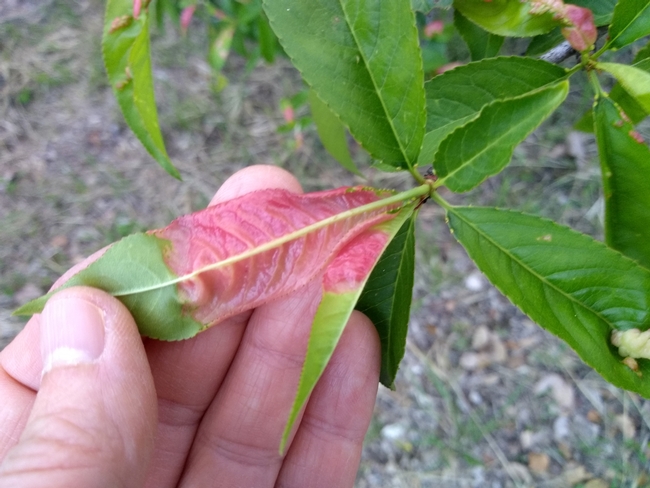
Taphrina deformans spores are produced in elongated structures called asci, a Latin word meaning “sacs”.
Have you noticed that Latin is used a lot for botanical descriptions? This is because Latin is a “dead” language and thus grammatically stable.
Taphrina's asci are lined up in layers on the leaf surface without any protective covering; therefore they are termed “naked asci”. So guess what name my Plant Pathology student volleyball team chose? Indeed, our t-shirts sported botanically correct drawings of Taphrina's asci, causing the other teams to think of us a bunch of weird science nerds. Nerds who played a pretty good game of volleyball mind you!
So what can you do to keep your trees healthy? Here are a few tips.
- If you are thinking of planting a peach or nectarine tree, investigate whether resistant varieties are available so you can avoid the problem altogether.
- For established trees, fall pruning of diseased shoots may help.
- Also for established trees, (organic) copper fungicide sprays in late fall after leaf drop and before budbreak in the spring may help.
- Addition of a horticultural oil may improve spray coverage. Be sure to follow the instructions on the label carefully.
If your tree got whacked by the disease, infected leaves will fall off and new leaves will develop but this requires the tree to expend additional energy. A foliar fertilizer application as well as fruit thinning can help the tree recover.
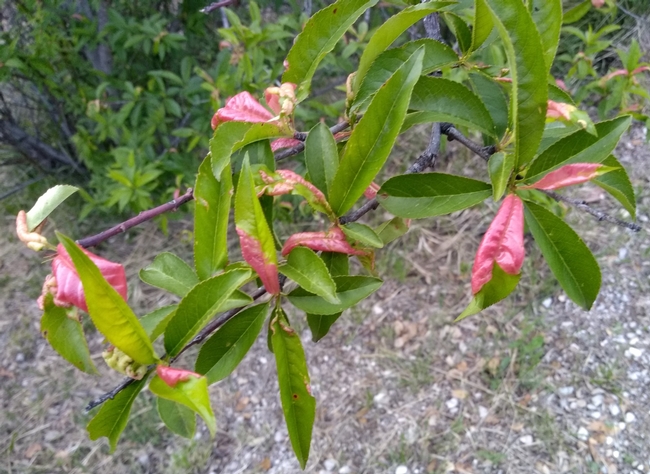
Related Reading:
Avocado Leaf Cuticle Limits Nutrient Uptake
Foliar fertilizer application is sometimes promoted as an effective means of supplying nutrients to avocado. On the market are various products being promoted as foliar nutrients for avocado, some proponents even suggest that their products do away with the need for soil applied nutrients. The nature of the avocado leaf severely limits its capacity to absorb foliar sprays.
The structure of plant leaves has evolved primarily to capture sunlight and exchange gases, roots have evolved to absorb nutrients and water and anchor the plant. Any absorption of nutrients by leaves is therefore likely to be more fortuitous than by design. In some crops passive nutrient absorption by leaves is occasionally sufficient to supplement the supply of nutrients taken up by the roots. Most often this involves trace elements, which as their name suggests are required in very small amounts (eg. copper and zinc). However if non-mobile elements or elements with limited mobility in the plant (eg. calcium, phosphorus, zinc, boron and iron) are absorbed when foliar sprayed they are not likely to make it down to the roots where they are also needed. Most nutrients will move freely in the water stream but the movement of many is restricted in the phloem, hence leaf applications don't meet the requirements of deficient trees. Occasionally major elements (such as nitrogen and potassium) are applied to make up for a temporary shortfall or provide a boost at a critical time. Citrus is an example of a crop where some benefits from foliar applied nutrients have been reported.
The ability of the leaf to absorb nutrients from its surface must depend to some degree on the permeability of its epidermis (outer layer) and the presence and density of stomates (pores for the exchange of gases). Scanning Electron Microscope studies of mature leaves and floral structures in avocado show the presence of a waxy layer on both the upper and lower surfaces of mature avocado leaves (Whiley et al, 1988). On the upper surface the wax appears as a continuous layer and there are no stomates. On the lower surface the wax layer is globular and stomates are present. Blanke and Lovatt (1993) describe the avocado leaf as having a dense outer wax cover in the form of rodlets on young leaves and dendritic (branching) crystals on old leaves including the guard cells (guard cells surround stomates). The flower petals and sepals in avocado have stomates on their lower surfaces and no wax layers on either surface, which might explain why floral sprays of boron might work.
Blanke, M.M. and Lovatt, C.J. 1993. Anatomy and transpiration of the avocado inflorescence. Annals of Botany, 71 (6): 543-547.
Whiley, A.W., Chapman, K.R. and Saranah, J.B. 1988. Water loss by floral structures of avocado (Persea americana cv. Fuerte) during flowering. Australian Journal of Agricultural Research, 39 (3): 457-467.
The avocado leaf, water beading up on the waxy cuticle.
An avocado leaf with its cuticle (white, paperlike surface) being exposed by underlying leaf fungi.
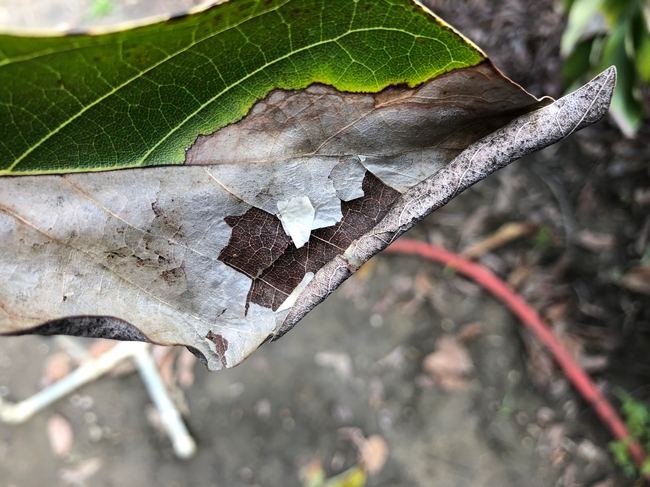
avocado cuticle
NOT a New Disease of Passionfruit
Passion fruit is widely grown and valued throughout the tropics and subtropics. Most Passifloras are vines which can climb to 20 or 30 feet. The fruit varies in color from purple to yellow-orange and in shape from an egg to a tennis ball. Inside its quarter-inch protective rind are numerous small seeds covered by a juicy aromatic, sweet-acidic pulp. The sweeter species are esteemed as a fresh fruit. The seeds are consumed with the pulp. The fruit is more commonly made into juice and often blended with other juices such as orange. The fruit also is used to make excellent ice creams, sherbets, jellies, and pies. The downside of the passion fruit is that most esteemed species are very frost tender. The best adapted to California of the subtropical species, the purple granadilla (P. edulis), is prone to a fusarium soil disease. However, there is a yellow form which, though not as sweet, is not subject to this disease. More importantly, the yellow form can be hybridized with the purple or used as a rootstock. The crop grows mainly along the coast where it enjoys the mild weather.
The purple ‘Frederick' variety is probably the most widely grown commercial variety in California. It's great tasting, and I've been known to suck the delicious innards of 15 fruit at a sitting. Aside from fusarium wilt, it has few pests or diseases. That was until this fall when fruit spotting started showing up on fruit and leaves. The cause is a fungus – Septoria spp. – which thrives in cool, moist conditions. These were exactly what we had this year. All summer long, there was fog along the coast, and this is what the fungus enjoys. It colonizes leaves, defoliating the plant and spreading to the fruit, causing Septoria Blotch (Spot). Once infected there's not much that can be done, other than preventing further spread to the rest of the vineyard.
Photo: Fruit Blotch
Fungal structures (pycnidia) growing on leaf, causing scarring spots
Disease symptoms:
- Leaves are the most affected organs, showing light brown slightly round necrotic spots normally encircled by a chlorotic halo. A single lesion per leaf is sufficient to cause abscission, and even leaves without visible symptoms may fall prematurely.
- When the disease reaches 15-20% of leaves in the same plant, partial or even complete leaf abscission is observed. In young twigs, lesions may promote girdling leading to wilt and twig tips death.
- Lesions on flowers are similar to those on leaves. The primary infection in the calyx may reach the stalk, causing the early drop of flowers. The infection may occur at any stage of the development of the fruits, affecting maturation or development.
- Leaf and fruit abscission, twig wilt and plant death may occur under disease favoring conditions.
Treatment: Under ideal conditions and forehand knowledge!!!!
1) Rake up infected leaves on the ground and bury or compost more than 50 ft away from the vines.
2) Pick off spotted fruit and leaves and remove from field as soon as possible as spores are being produced in the lesions and can infect surrounding leaves and fruit when moisture is present.
3) During periods with dew, rain or ocean mist, spray Abound (azoxystrobin) or generic version of this fungicide on the vines. It distributes well over the foliage and fruit, is fairly rainfast, and gives about 2 weeks' protection.
4) To minimize the risk of the fungus developing resistance to Abound, apply a copper fungicide between Abound sprays, for instance Cueva (copper octanoate) is a good product and approved for organic production. Copper is a protectant and needs good coverage to be effective. It provides about 7 days of protection, possibly longer without rain.
So this year has been weird. Most years are. Lots of rain, no freezes, but it was a cold winter. Then all this fog in the summer that normally clears up going into summer. it seems like there's always something new. Had that funny scale on citrus again this year - wax scale - And the effects of fire can always bring a round of new pests. And there is always a new winter waiting for us.
Photo: Leaf and fruit spotting (blotch) from Septoria.

